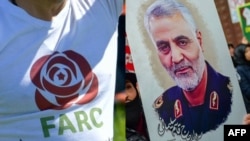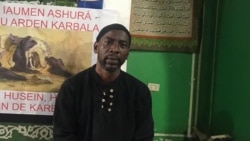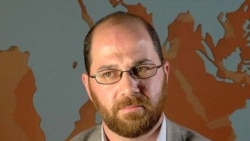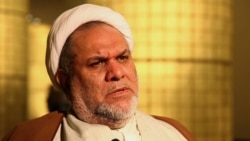Buenaventura is one of the most violent and poorest cities in Colombia. In one of the most dangerous neighborhoods, a music sang by children voices is wafting from a house with a big sign saying Mezquita in front of it. It is a mosque and a headquarters of the local Shia Muslim community led by Sheikh Munir Valencia, a Colombian cleric who got educated in Iran.
Munir Valencia was born in Buenaventura. His mother raised him to be a proper Christian. When he was preparing to go to service of God and work in a church, he met a girl from a Muslim family which made him question his religion and eventually he converted. As a new ardent Muslim, he was offered a scholarship to study in a famous mosque in Buenos Aires under a prominent Iranian cleric Mohsen Rabbani.
As he later proved his talent and devotion to Islam, he and his wife were given an opportunity to study in Qom. As he describes, he got everything for free, starting from education and accommodation to transportation and other benefits. Once he came back, he started to run an educational and cultural center as well as a local mosque to practice his religion and share it with the community.
Munir Valencia is not the only one in Latin America who converted to Shia Islam and traveled to Qom to get an Islamic education to spread in local communities. In fact, Iranians have built a well-structured and systematic network of cultural centers and local mosques usually led by converts trained in Iran with an aim to recruit local people and increase Tehran’s influence in the region.
As Emanuele Ottolenghi, an expert on activities of Iran in Latin America from Foundation for Defense of Democracies, explains “When people convert, they travel to Iran and the trip is fully funded by the regime. It is usually a two-month trip during which they take classes, see the Iranian [religious] culture, holy sites, or battlefields of the Iraq- Iran war. Part of this process is designed to identify the most talented students because most of them come back or stay in Qom even for years to train to become clerics.”
When they come back, their role is clear –promote their religion and the Iranian regime. The cultural centers seem to be the most convenient way to do so as it allows them to organize events, publish texts in Spanish or spread their message on social media.
The cultural centers are integrated in a systematic network spearheaded by an organization called Islam Oriente. “They have a whole range of publications for the Hispanic community, they overwhelmingly produce in Spanish but they also started to publish in Portuguese and the range of publications is impressive – they have a quarterly journal that is history, philosophy, theology or they also have publications for children called Los Angelitos,” summarizes Ottolenghi.
The organization is based in Qom and is led by Mohsen Rabbani, one of the leading persons in Iranian operations in Latin America who came to Argentina at the beginning of 1980’s to spread the message of the Islamic revolution. According to Argentinian judicial authorities, Mohsen Rabbani was implicated in the bombing of a Jewish Community Center (AMIA) in Buenos Aires in 1994. Based on the information of an investigation report by Alberto Niesman, Argentinian government issued a still-standing international arrest warrant and an INTERPOL red notice which forced him to leave Argentina and move back to Iran.
Prior to his departure, Rabbani proved to be very successful in his missionary work guiding numerous converts and helping them to strengthen their faith. He has developed especially strong relationship with the Argentinian-born Lebanese descendant Suhail Assad who has become one of the most prominent figures in Iranian propaganda campaign in Latin America.
“Suhail Assad was born in Buenos Aires; he went to university where he studied theater and acting. However, he found out he had some sort of spiritual epiphany, so he decided to journey back to Lebanon to the village of his ancestors. He was probably recruited because he started to study there to become a cleric and eventually moved over to Iran where he was ordained as a cleric in Qom in a seminary for foreign students. From there he eventually became in charge of spreading the word in Latin America,” says Ottolenghi.
Assad is also the face of Iranian propaganda as he has hosted several religious programs broadcast on HispanTV, he has been a subject of a documentary movie about his life and hosted a documentary series about Muslim converts in several countries on the continent.
Although he is generally located in Qom, he often travels across Latin America to carry out missionary work, giving lectures at universities and helping locals to establish their cultural centers. According to open sources, he has laid the foundations of more than 20 Islamic centers in Latin America and has visited more than 80 universities, lecturing about the Islamic Revolution in Iran or about Shia Islam.
This way, Assad has become an important link between local cultural centers and the Qom-based sponsoring organization, Islam Oriente. This connection is further enhanced by an Islam Oriente operation called Center for Iranian-Latin American Cultural Exchange which is based in Caracas and where Suhail Assad is usually operating from while travelling in Latin America.
Having extensive ties in Latin American Shia Islamic community and close relationship with Mohsen Rabbani, he has been associated with several international watch terrorism lists or connected to the 1994 AMIA attack due to which he was banned from entering to Mexico.
Assad is also a brother-in-law of Argentinian cleric, who succeeded Rabbani at the Buenos Aires at-Tauhid mosque and Rabbani’s first convert and right-hand man, Abdul Karim Paz. Due to the close relation with Suhail Assad, Abdul Karim Paz very often appears in his shows on Hispan TV explaining Shia principles of Islam. According to Emanuele Ottolenghi “he is reportedly in charge of accompanying coverts from Latin America to Iran.” He has also helped to establish several cultural centers in Chile and Bolivia. In a book called Iran’s Strategic Penetration of Latin America he is described as an influential person “managing Mohsen Rabbani missionary operations targeting Argentinians and also in developing the younger generation of Islamists in Argentina such as Suhail Assad.”
Iranian operation in Latin America, however, extends beyond the Spanish speaking world. In Brazilian capital Sao Paulo, it is possible to find several Iranian cultural centers. Two of them, Islamic Benevolent Religious Organization and center Arresala, are operated by Sheikh Taleb Hussein al-Khazraji, an Iraqi born cleric who was sent to Brazil not long after Mohsen Rabbani. “Al-Khazraji has been involved in Iran’s network since the early 80’s. Before he came to Sao Paolo in 1989, he was in Tanzania,” explains Ottolenghi.
His name is also mentioned in the investigation documents of 1994 attack in Buenos Aires as an “employee of Iranian government who recruits believers to get them closer to Tehran.”
Bilal Mohsen Wehbe is another character who has been operating alongside Khazraji and who was sanctioned ten years ago by the United States as a “chief representative of Hezbollah in Latin America” as he, according to the U.S. Department of Treasury “had relayed information and directives between Hizballah leaders in Lebanon and Hizballah elements in South America.” He has been active in the mosque until recently.
Iran has a very detailed and structured strategy to expand its influence. The cultural system is based on three pillars which are linked in a certain hierarchy. Islam Oriente from Qom spearheads the network in Latin America by its operational Center for Iranian-Latin American Cultural Exchange based in Caracas. The local cultural centers are connected by these two organizations and are usually led by locals who were recruited by one of the missionaries or clerics such as Mohsen Rabbani, Suhail Assad or Taleb Khazraji.
According to Emanuele Ottolenghi, they are successful in their operations. “They don’t take everybody – the recruitment process is very slow, they vet people very carefully before they bring them onboard. So, they do not recruit tens of thousands of people, but they are more likely in hundreds. However, the people they bring onboard tend to be true believers through and through - the part of that is that they indoctrinate them for years because they need them for a lifetime to slowly win over civil society.”











